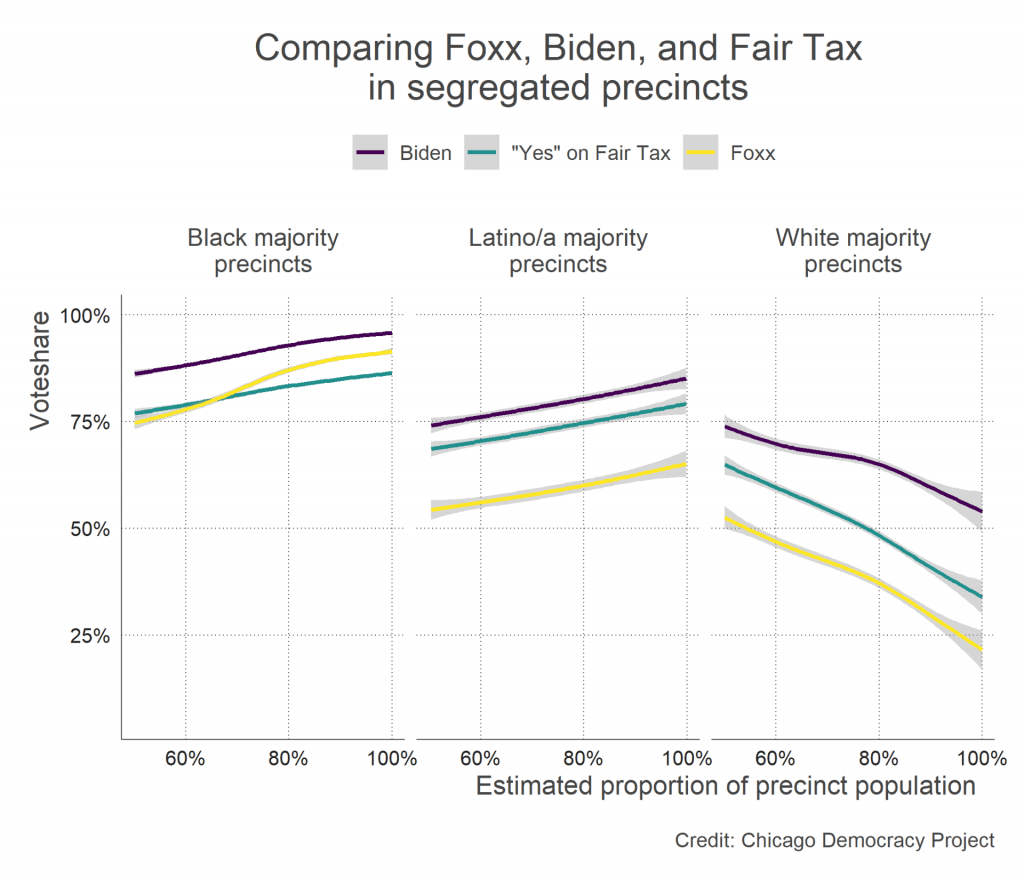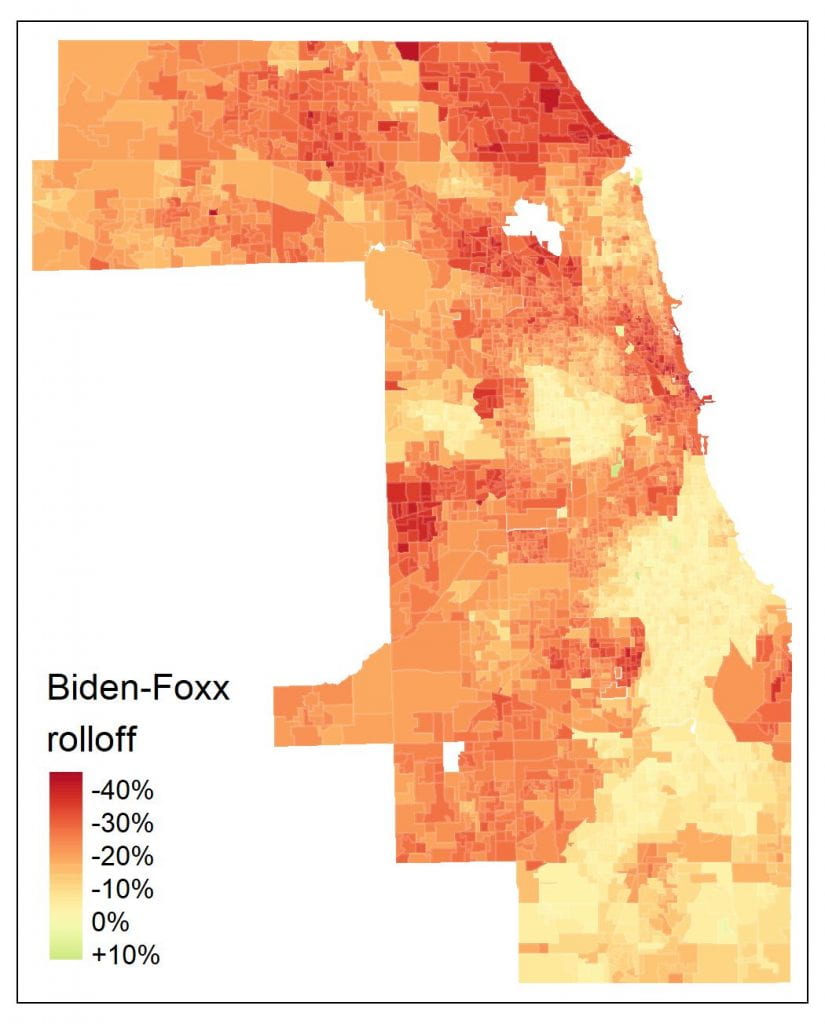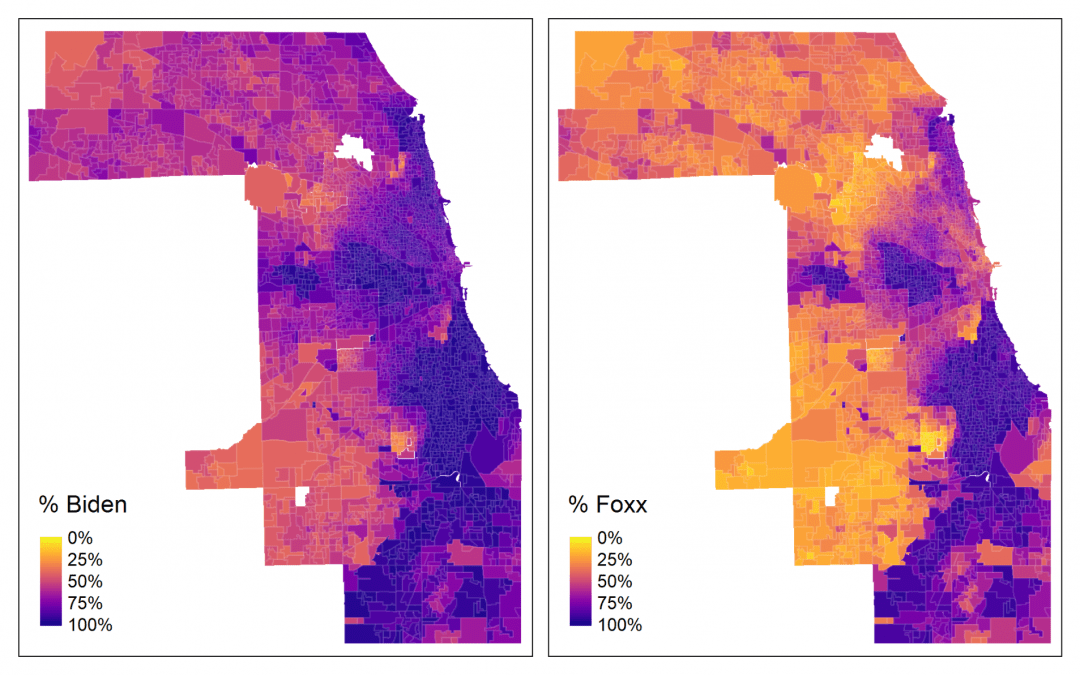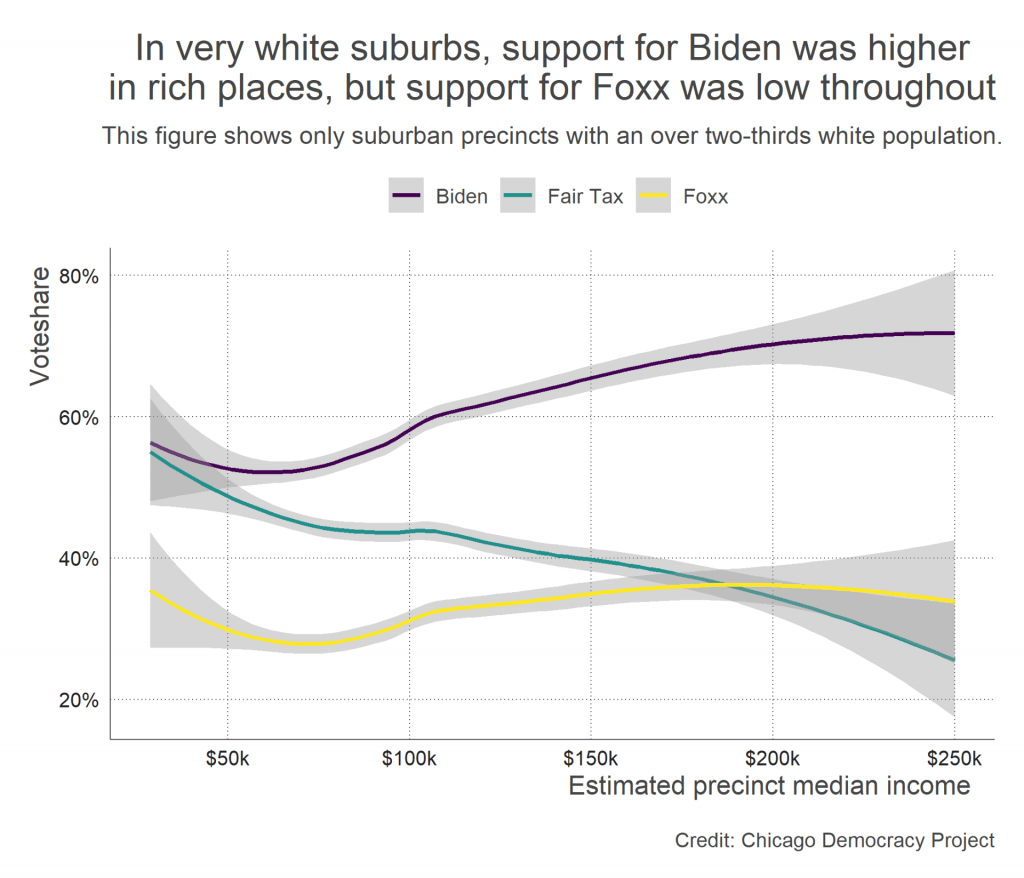by Kumar Ramanathan, Tom Ogorzalek, and Bianca Varlesi
One of the many features of Democrats’ success in the 2020 election was the maintenance or strengthening of the party’s dominance in urban areas. This dominance, however, masks the ideological complexity of the party’s metropolitan coalition. Because they combine so many dimensions into one ballot decision, the results of presidential elections alone cannot teach us much about the “big tent” of the Democratic Party base. To learn more, we need to compare voters’ support for the top of the ticket to their preferences on particular issues. The 2020 election in Cook County gives us the opportunity to make such a comparison. Downballot from the presidential election, voters had the opportunity to express their preferences on criminal justice reform through their vote for Cook County State’s Attorney, where incumbent Kim Foxx has run on a reform platform. They also expressed their preferences on progressive taxation in the “Fair Tax” referendum. On both criminal justice and fiscal redistribution, the coalition was fractured.
Foxx won re-election as Cook County State’s Attorney comfortably, defeating her Republican opponent Pat O’Brien by a 14.9-point margin. Her 54.1% share of the vote, however, lagged far behind Joe Biden’s 74.3% vote share in Cook County. What’s driving that 20-point gap? We can dig into precinct-level election returns to analyze where this gap between Biden and Foxx emerged. The precinct returns show that the Biden-Foxx gap is widest in the majority-white neighborhoods on Chicago’s North Side and in suburban Cook County.
Foxx initially ran as a challenger in 2016, as part of an emerging wave of “progressive prosecutors” who promised to use their offices to reduce mass incarceration and pursue criminal justice reforms. She won the 2016 Democratic primary with 58.3% of the vote, upsetting incumbent Anita Alvarez. She then cruised to victory in the November 2016 general election with 72.1% of the vote, almost matching the 73.9% that Hillary Clinton received in the same election.
After four years of Foxx’s tenure as State’s Attorney, the 2020 election serves as a test of Cook County’s appetite for a progressive prosecutor. Foxx won the March primary election comfortably against three challengers, but her overall share of the vote dropped to 50.2%. In a precinct-level analysis comparing the two primary elections, we found that Foxx retained overwhelmingly strong support in Black neighborhoods across the county and moderate support in most of the city’s Latino neighborhoods, but lost support in white neighborhoods by about 10 points.
In this November’s general election, Foxx’s base of support was rooted in similar parts of the county. Unlike 2016, however, many Democratic voters in areas where Foxx struggled in the primary were willing to defect from the party and vote for her Republican opponent Pat O’Brien. To examine these patterns more closely, we calculated estimates of each precinct’s racial demographics using Census data. Even though no ethnic or racial group makes up a majority of Cook County residents, because of segregation about half of precincts have one racial group comprising over 75% of their population. Comparing these different places lets us see how segregated communities made choices across their ballot. The figure below compares the vote share received by Biden, Foxx, and the Fair Tax referendum in precincts with a majority Black, Latino, or white population.

For details on estimation procedures for precinct racial demographics and plotting smoothed averages, please see footnotes 2-4 here.
In the majority-Black neighborhoods on the West and South Sides and southern suburbs, Foxx retained sky-high support and trailed only a few percentage points behind Biden. In majority-Latino neighborhoods, Foxx consistently won a majority but trailed about 15 points behind Biden. Foxx’s losses were concentrated in white-majority neighborhoods, where she trailed Biden by around 25 points.
 The defection of Democrats in white neighborhoods is stark on Chicago’s North Side and its affluent suburbs. Across the city’s North Side, Biden won about 80% to 85% of the vote but in white-majority precincts, Foxx only won about 50% to 55%—a gap of about 30 points. In suburban Cook County, the drop-off from Biden to Foxx is pronounced in the lakefront areas north of the city. In many other white-majority suburbs, the drop-off is smaller because Biden’s performance was less dominant, coming closer to the lower levels of support Foxx garnered here.
The defection of Democrats in white neighborhoods is stark on Chicago’s North Side and its affluent suburbs. Across the city’s North Side, Biden won about 80% to 85% of the vote but in white-majority precincts, Foxx only won about 50% to 55%—a gap of about 30 points. In suburban Cook County, the drop-off from Biden to Foxx is pronounced in the lakefront areas north of the city. In many other white-majority suburbs, the drop-off is smaller because Biden’s performance was less dominant, coming closer to the lower levels of support Foxx garnered here.
We can also see this pattern of downballot defection in the referendum on the Fair Tax, which would have replaced the state’s flat tax rate with a progressive tax with higher rates on those with higher incomes. While the Fair Tax was broadly supported by Democratic Party officials and was a top priority of Governor J.B. Pritzker, the referendum dramatically underperformed Joe Biden on the ballot. This downballot defection, once again, was concentrated in segregated white neighborhoods. In the white-majority precincts, the Fair Tax trailed Biden by 15 points, while it only trailed by 5 to 10 in Black and Latino-majority precincts.
These results suggest that the increasingly Democratic metropolitan coalition is a precarious one when it comes to certain key issues. The gap between national partisanship and support for Foxx was very high in the lakefront suburbs north of the city, which is an area of extreme affluence. Foxx did no better there than in more working-class predominantly white suburban precincts where voters were more likely to choose Trump over Biden as well. By contrast, while Biden’s support is stronger in more affluent white suburban precincts, support for progressive taxation was much lower there.
Foxx’s position is different from some of the other high-profile progressive prosecutors in Philadelphia, San Francisco, and Brooklyn, where the central city and county boundaries are the same. Suburbs in those places do not have a say in the central city’s efforts at reform. Conversely, about half of the Cook County electorate lives in suburban communities where big-city challenges of public safety and police misconduct are far less immediate (but perhaps no less salient due to a shared local news media market). While affluent suburbanites may have been repelled by Trump, on issues such as criminal justice and taxation, it is not clear that they are all comfortable with actual policy changes meant to address ongoing racial injustices.
Beyond foreshadowing continuing local debates about how to manage public safety and law enforcement in the nation’s second-largest county, these results highlight the fragility of the national Democratic coalition: while they appear to be more and more supportive of Democratic candidates, they may be far less supportive of the actual economic and civil rights policies that are the modern party’s biggest difference with the GOP.



You must be logged in to post a comment.